Now winter has taken a firm grip on Europe after all: Cold, ice and snow all the way to the lowlands. Not only warm rooms, but also warm drinks are in demand, with and without alcohol: grog, tea, punch, even mulled wine has survived the Christmas days. Warmth is sought after. Even with wine? In fact, the question arises: what does the wine lover drink in winter when it is cold outside and the snow remains? Wine is a child of the sun and not of the cold.
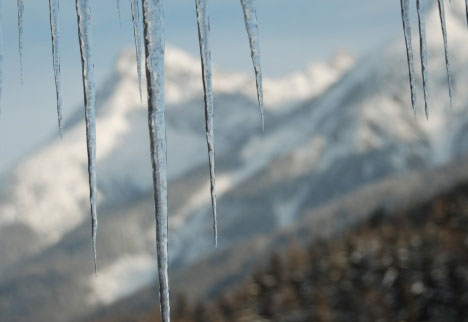 |
| Ice and snow in the Swiss mountains (Photo: P. Züllig) |
I've never really thought about that before. After all, wine with food has nothing to do with the temperature outside and certainly nothing to do with ice and snow, which are left outside. And yet: wine is consciously or unconsciously associated with feelings, with moods, with sun, light and warmth just as much as with cold, snow and ice. There are obviously wines that are more suited to one mood or the other. A walk in the freezing cold with snow crunching under your soles, a skiing or snowboarding adventure or even just looking through the window at a snow-covered landscape - all this influences the choice of wine more than we realise. There is such a thing as winter wines; they are wines that match the winter magic or can withstand dreary, wet and cold winter days. But do they have names, these wines, can we define their characteristics, are there certain grape varieties that do particularly well?
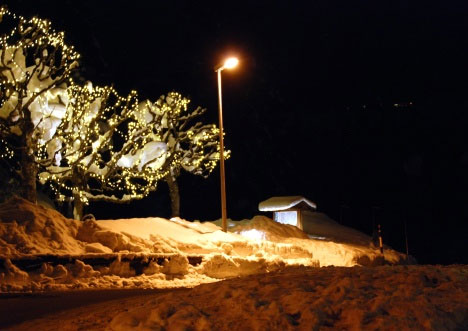 |
| Winter magic. Which wine suits this landscape? (Photo: P. Züllig) |
Perhaps every statement about this is risky, perhaps every wine drinker associates winter moods with different feelings. On a cold winter day - minus 16 degrees - we walk along a snowy forest path to a remote inn to celebrate a birthday: wonderful home cooking, specialities of the region. I have to (or am allowed to) choose the wine. It is immediately clear to me: it has to be a local one! There is not much on offer, but a Graubünden wine is the right choice, of course one from the Herrschaft. I know the one wine - Pinot Noir, of course - from an excellent winemaker, a good vintage, an excellent wine. And yet - it just doesn't inspire us, even though it goes well with the food. What's wrong? It was only then that I really realised that enjoying wine also has a lot to do with mood - with weather, landscape, nature. Outside: a winter fairy tale. It's freezing cold - but the landscape is enchanted, a lonely area at the foot of white mountains, illuminated by moonlight, above it - crystal clear and glittering - the starry sky. In the restaurant there is a lot of warmth from the stove, the voices seem muffled by the clothes and the protection from the cold, not even the glasses sound right when we toast. People move closer together, they appreciate the fact that the parlour is cramped, really a warm room.
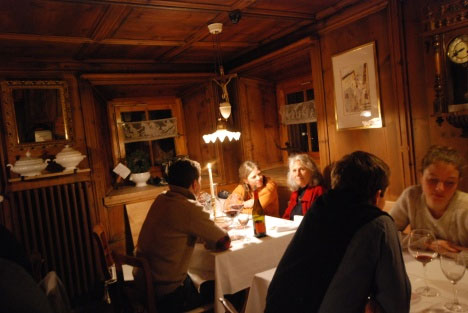 |
| Cosy dining room in a mountain restaurant (Photo: P. Züllig) |
In this atmosphere - I think I grasp intuitively - a filigree Pinot doesn't stand a chance. Colours come to mind. Don't we also talk about colour temperatures, about "warm" and "cold" colours? This has nothing to do with warmth, measured in Celsius or Fahrenheit, but it does with perception and feelings. Couldn't this also be the case with wine, somehow play a role in how we feel? The more I think about it, the more daring but also coherent my comparisons become. A champagne or sparkling wine would fit the mood quite well, with its sparkling, bright, glittering splendour a piece of the outside would come inside. Although no one actually feels like a cool drink now. The idea of champagne is accepted. "Snow champagne" in the parlour, so to speak. But then it becomes more difficult: to find a counterpart to the warm, cosy mood of red wine. Pinot is definitely the wrong choice. That's when "Veltliner" comes to mind; a wine (mostly Nebbiolo) grown directly in the south of the canton Graubünden from Tirano to Lake Como and which has the reputation of being a "mountain wine". Wonderful to drink in a mountain hut at an altitude of two or three thousand metres when it is night outside, the sun has long since disappeared and the winds are whistling around the hut: a "warm" wine that not only warms the throat, but also the heart.
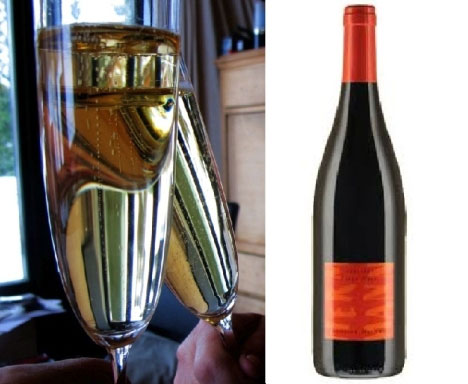 |
| Champagne or red wine% is a Pinot the right wine? (Source: P. Züllig) |
And then, from the same region, the speciality, the Sforzato. Obtained from grapes laid out on a wooden grate. A rich, dry wine with a high alcohol content. A real "high-altitude wine" that has already had a - not always pleasant - effect on many a ski tour. I sit - thankfully only in my imagination - on the bench at the edge of the forest, under snow-covered fir trees, mountains high above me in the bluish moonlight, the starry sky even higher up. There I climb - in my mind, of course - into the cellar, search for the oldest, dustiest bottles and am convinced: a winter wine must be an old wine, a mature wine, a rounded, clarified wine that has long since weathered the storms of a wine's life.
The depiction of the seasons in medieval paintings - recently marvelled at in the museum - emerge. There, winter is repeatedly symbolised by an old man holding a cup in his hand, often wearing a victory wreath on his head. Of course, this is also an allusion to death - but also to inner warmth, maturity, serenity, perfection. For me, there has been a "winter wine" ever since: it bears the traces of spring, of impetuous growth, of maturity. But it has calmed down so much, it is so much calmed down and at peace with itself, that it radiates "warmth". That inner warmth that one looks for in winter - when it is bitingly cold outside - and can also find in the wine. Possibly much more concisely than in "warm" colours or even warm drinks.
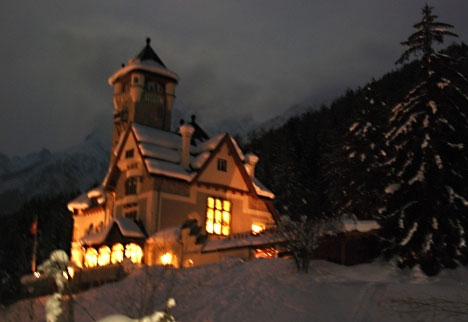 |
| Warm and cold - not only in nature% also in the choice of wine (Photo: P. Züllig) |
For me, at the latest after this winter experience, warmth is not only a question of temperature, but rather a question of feeling and experiencing. That's why, for me, there is such a thing as "warm" wine, even if it is not so easy to define and certainly not to assign to a grape variety or a wine region. Not even to a certain age. Rather the willingness of wine lovers to feel the "warmth".
Cordially
Yours/Yours